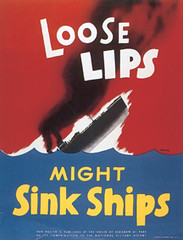Every now and again, Ragan Communications hits upon a good story related to social media. Michael Sebastian did yesterday.
Less interesting are the feuding comments that followed, which do nothing more than polarize the issue into this or that, black and white. Despite the back and forth, everyone seems to ignore that lost workplace productivity, now blamed almost exclusively on social networks, predates the social network explosion last year.
In 2006, it was estimated that employees spent an average of 1.86 hours every eight-hour workday on something other than their jobs, not including lunch and scheduled breaks. Some of it was surfing the net. However, many attributed time wasting to socializing with co-workers, running errands outside the office, and "spacing out."
The Recap
Ragan Communications polled 430 professional communicators from North and South America, asking them if their companies permit access to social media sites. The majority said they did, but 31 percent are still left in the dark.
The list of banned sites includes just about everything: Facebook, MySpace, YouTube, Flickr, Twitter, Squidoo, Second Life, blogs, podcasts, video-sharing sites, streaming, and, er, everything.
But does banning these sites from the office reverse wasted productivity attributed to “spacing out?” Probably not. Will employees be given enough to do to fill their time? Doubtful. Will leadership engage employees on a level that motivates them to excel? Unlikely.
Banning Abounds
The “workplace bans Internet” topic is being listened too despite being tired. Ironically, while Americans seem chafed that countries ban certain sites, they’re happily banning themselves under certain circumstances.
Not only at work, but more universities are continuing to ban Google and Wikipedia. It's common nowadays and hardly news.
While it is true that neither Google nor Wikipedia are adequate sources when working on "scholarly" papers (or client projects, I might add), banning Internet resources negates suitable uses for the tools, much like banning them at the workplace.
There is nothing wrong with using these tools to “source” for sources, in my opinion. Sometimes searching for key information is quicker, leading you to the appropriate journal, article, newspaper archive, published government report, interviewee, or lecture podcast from Harvard. And I guess that brings me to wonder ... why?
Social Media Is A Tool
I never understood the concept that social media is more of a lifestyle choice as opposed to a versatile tool, especially in academics and in the workplace. While people keep framing it up as "good or bad," it seems to me that it all comes down to acceptable usage and asking the right questions.
Do we want an air traffic controller surfing the net? Probably not. But open access to the net sure seems to make sense for an employee in charge of business development. Competitors have Web sites. And some of them have FaceBook accounts. So do prospects, I imagine.
So what’s the right question? How about … how do we teach students and employees to use the net for specific purposes that coincide with their assignment or job as opposed to overreaching or simply entertainment? And, if their productivity drops as the result of abuse or if they cite Wikipedia as a primary source (yikes!), what constitutes appropriate action? That seems more productive to me.
In contrast, blanket bans seem to limit how much material might be considered for a scholarly paper and/or dictate how you want your employees to waste their time, which they might just do anyway.
“We’d rather they just space out, Richard.”
Survey says … just space out? Six percent already do.

Less interesting are the feuding comments that followed, which do nothing more than polarize the issue into this or that, black and white. Despite the back and forth, everyone seems to ignore that lost workplace productivity, now blamed almost exclusively on social networks, predates the social network explosion last year.
In 2006, it was estimated that employees spent an average of 1.86 hours every eight-hour workday on something other than their jobs, not including lunch and scheduled breaks. Some of it was surfing the net. However, many attributed time wasting to socializing with co-workers, running errands outside the office, and "spacing out."
The Recap
Ragan Communications polled 430 professional communicators from North and South America, asking them if their companies permit access to social media sites. The majority said they did, but 31 percent are still left in the dark.
The list of banned sites includes just about everything: Facebook, MySpace, YouTube, Flickr, Twitter, Squidoo, Second Life, blogs, podcasts, video-sharing sites, streaming, and, er, everything.
But does banning these sites from the office reverse wasted productivity attributed to “spacing out?” Probably not. Will employees be given enough to do to fill their time? Doubtful. Will leadership engage employees on a level that motivates them to excel? Unlikely.
Banning Abounds
The “workplace bans Internet” topic is being listened too despite being tired. Ironically, while Americans seem chafed that countries ban certain sites, they’re happily banning themselves under certain circumstances.
Not only at work, but more universities are continuing to ban Google and Wikipedia. It's common nowadays and hardly news.
While it is true that neither Google nor Wikipedia are adequate sources when working on "scholarly" papers (or client projects, I might add), banning Internet resources negates suitable uses for the tools, much like banning them at the workplace.
There is nothing wrong with using these tools to “source” for sources, in my opinion. Sometimes searching for key information is quicker, leading you to the appropriate journal, article, newspaper archive, published government report, interviewee, or lecture podcast from Harvard. And I guess that brings me to wonder ... why?
Social Media Is A Tool
I never understood the concept that social media is more of a lifestyle choice as opposed to a versatile tool, especially in academics and in the workplace. While people keep framing it up as "good or bad," it seems to me that it all comes down to acceptable usage and asking the right questions.
Do we want an air traffic controller surfing the net? Probably not. But open access to the net sure seems to make sense for an employee in charge of business development. Competitors have Web sites. And some of them have FaceBook accounts. So do prospects, I imagine.
So what’s the right question? How about … how do we teach students and employees to use the net for specific purposes that coincide with their assignment or job as opposed to overreaching or simply entertainment? And, if their productivity drops as the result of abuse or if they cite Wikipedia as a primary source (yikes!), what constitutes appropriate action? That seems more productive to me.
In contrast, blanket bans seem to limit how much material might be considered for a scholarly paper and/or dictate how you want your employees to waste their time, which they might just do anyway.
“We’d rather they just space out, Richard.”
Survey says … just space out? Six percent already do.






















